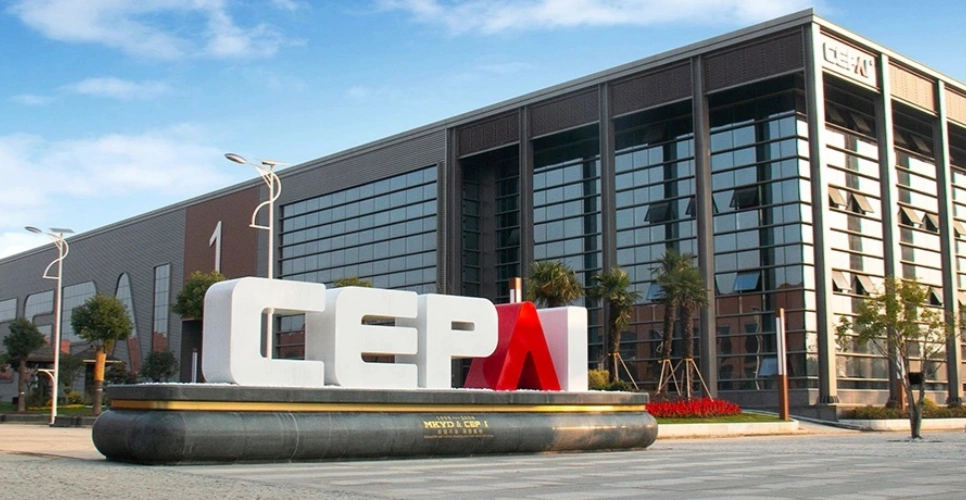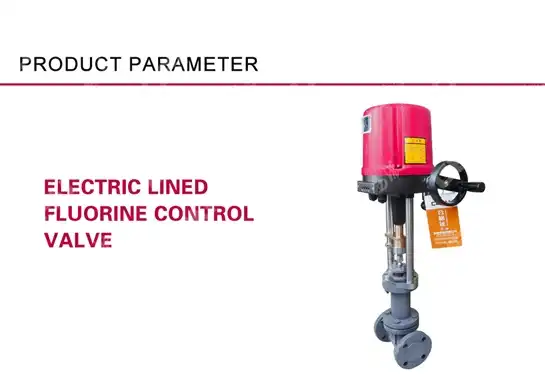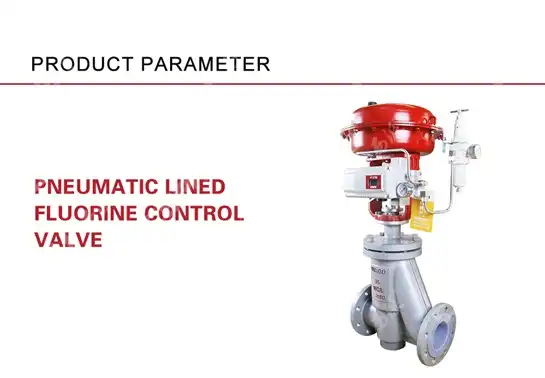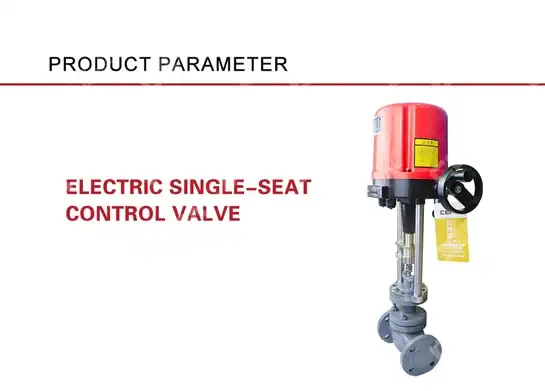Thermal Conductivity in Self-operated Valves: What Engineers Should Know
Understanding thermal conductivity properties in self-operated valves is crucial for engineers designing efficient fluid control systems across various industrial applications. The thermal behavior of these autonomous control devices directly influences their operational effectiveness, response time, and overall system performance. Modern Self-operated Control Valve systems rely on precise thermal management to maintain optimal working conditions while ensuring reliable operation in demanding environments. This comprehensive guide explores the critical thermal considerations that engineers must evaluate when selecting, designing, and implementing self-operated valve solutions in industrial processes.

Material Properties and Thermal Design Considerations
Advanced Materials for Enhanced Thermal Performance
The selection of appropriate materials plays a fundamental role in optimizing thermal conductivity within Self-operated Control Valve applications. High-performance alloys such as stainless steel 316L, Inconel, and specialized nickel-based superalloys offer superior thermal conductivity characteristics while maintaining excellent corrosion resistance properties. These materials demonstrate exceptional heat transfer capabilities, enabling rapid thermal response and improved control accuracy in temperature-sensitive applications. Engineers must carefully consider the thermal expansion coefficients of these materials, as differential thermal expansion can significantly impact valve sealing performance and operational reliability. The integration of thermally conductive materials in valve body construction facilitates efficient heat dissipation, preventing thermal stress accumulation that could compromise valve integrity over extended operational periods. Modern valve manufacturing incorporates advanced metallurgical processes to enhance material thermal properties while maintaining mechanical strength requirements. Heat treatment processes such as solution annealing and precipitation hardening optimize the microstructure of valve components, improving both thermal conductivity and mechanical durability. The careful selection of seat materials, including PTFE variants and metal-seated configurations, directly influences thermal transfer characteristics and operational temperature ranges. Engineers should evaluate the thermal interface between different materials within the Self-operated Control Valve assembly to minimize thermal resistance and optimize overall system performance.
Thermal Expansion Management in Valve Design
Effective thermal expansion management represents a critical aspect of Self-operated Control Valve design, particularly in high-temperature applications where significant temperature variations occur during normal operation. The differential thermal expansion between valve components can create internal stresses that affect sealing performance and overall operational reliability. Engineers must implement design strategies that accommodate thermal growth while maintaining precise control characteristics throughout the operational temperature range. This includes the incorporation of flexible bellows assemblies, spring-loaded seating mechanisms, and thermally compensated actuator systems that automatically adjust for temperature-induced dimensional changes. The implementation of thermal barrier coatings and insulation systems helps manage heat transfer within valve assemblies while protecting sensitive internal components from excessive temperature exposure. These protective systems enable Self-operated Control Valve applications in extreme temperature environments while maintaining precise control functionality. Engineers should consider the thermal mass of valve components when designing systems requiring rapid temperature response, as larger thermal masses inherently exhibit slower thermal response characteristics. The optimization of component geometry and material distribution can significantly improve thermal response times while maintaining structural integrity requirements.
Heat Transfer Optimization Strategies
Optimizing heat transfer characteristics within Self-operated Control Valve systems requires comprehensive understanding of conduction, convection, and radiation heat transfer mechanisms. The valve body geometry significantly influences internal heat transfer patterns, with streamlined internal passages promoting efficient thermal exchange between the process fluid and valve components. Engineers can implement enhanced heat transfer surfaces, including fins and extended surfaces, to improve thermal conductivity performance in applications requiring rapid temperature response. The strategic placement of thermal sensors and temperature-sensitive elements ensures accurate temperature measurement while minimizing thermal lag effects that could compromise control accuracy. Advanced computational fluid dynamics modeling enables engineers to optimize heat transfer characteristics during the design phase, identifying potential thermal hot spots and optimizing component placement for improved thermal management. The integration of thermal modeling with mechanical stress analysis provides comprehensive understanding of thermal-mechanical interactions within Self-operated Control Valve systems. This integrated approach enables the development of valve designs that maintain optimal performance characteristics across wide temperature ranges while ensuring long-term operational reliability.
Industrial Applications and Performance Requirements
Petrochemical Industry Applications
The petrochemical industry presents unique challenges for Self-operated Control Valve applications, with demanding thermal conductivity requirements driven by extreme operating conditions and stringent safety regulations. These applications typically involve high-temperature hydrocarbon processing, where thermal stability and rapid temperature response are critical for maintaining process control and preventing dangerous operating conditions. The thermal conductivity characteristics of valve materials directly influence their ability to withstand thermal shock conditions common in petrochemical processes, including emergency shutdown scenarios and rapid process transitions. CEPAI Group's extensive experience in petrochemical valve applications demonstrates the importance of thermal design optimization in these demanding environments. The company's API-certified valve products incorporate advanced thermal management features specifically designed for petrochemical service, including enhanced heat dissipation capabilities and thermal stress management systems. Engineers working in petrochemical applications must consider the thermal compatibility of Self-operated Control Valve components with various hydrocarbon fluids, as some process chemicals can significantly affect material thermal properties over time. The integration of thermal monitoring systems within petrochemical Self-operated Control Valve installations enables real-time assessment of thermal performance and early detection of potential thermal-related issues. This proactive approach to thermal management helps prevent costly process interruptions while ensuring optimal valve performance throughout the service life. Advanced diagnostic capabilities allow engineers to optimize thermal performance parameters based on actual operating conditions rather than theoretical design assumptions.
Power Generation and Steam Systems
Power generation applications place extraordinary demands on Self-operated Control Valve thermal performance, particularly in steam turbine systems where precise temperature control is essential for maintaining optimal efficiency and preventing equipment damage. The high thermal conductivity requirements of these applications necessitate specialized valve designs that can rapidly respond to temperature changes while maintaining precise control characteristics. Steam applications present unique thermal challenges due to the significant temperature differences between steam and condensate phases, requiring valve designs that can accommodate rapid thermal transitions without compromising performance. The thermal mass optimization of Self-operated Control Valve components becomes critical in power generation applications where rapid load changes require immediate thermal response. Engineers must balance the structural requirements for high-pressure steam service with the need for minimal thermal mass to achieve rapid temperature response. This often involves the use of advanced materials and innovative design approaches that maintain mechanical integrity while optimizing thermal characteristics. Thermal fatigue considerations become paramount in power generation applications due to the cyclic nature of thermal loading during plant startup, shutdown, and load-following operations. The thermal conductivity properties of valve materials directly influence their resistance to thermal fatigue, making material selection a critical design consideration. CEPAI Group's experience in power generation valve applications demonstrates the importance of comprehensive thermal analysis in achieving reliable long-term performance in these demanding applications.
Process Industries and Chemical Manufacturing
Chemical manufacturing processes present diverse thermal challenges for Self-operated Control Valve applications, ranging from cryogenic services to high-temperature reaction control. The thermal conductivity requirements vary significantly depending on the specific chemical process, with some applications requiring rapid thermal response while others prioritize thermal stability and minimal temperature variation. The chemical compatibility of valve materials with process fluids can significantly influence thermal conductivity characteristics over time, requiring careful material selection and performance monitoring. The implementation of Self-operated Control Valve systems in chemical manufacturing often involves complex thermal management requirements due to exothermic and endothermic reaction control needs. Engineers must consider the thermal interaction between the valve system and the surrounding process equipment to ensure optimal overall system performance. This includes evaluation of thermal losses, heat recovery opportunities, and thermal efficiency optimization strategies that can improve overall process economics while maintaining precise control performance. Advanced thermal modeling techniques enable engineers to predict thermal performance characteristics under various operating conditions, facilitating optimized valve selection and system design. The integration of thermal performance data with process control systems enables dynamic optimization of thermal management strategies based on real-time operating conditions, improving both performance and energy efficiency in chemical manufacturing applications.
Technology Comparison and Future Trends
Traditional vs. Advanced Thermal Management Technologies
Traditional Self-operated Control Valve designs relied primarily on passive thermal management approaches, utilizing material thermal properties and basic geometric considerations to achieve acceptable thermal performance. These conventional designs often exhibited significant thermal lag and limited temperature range capabilities, particularly in applications with rapid temperature changes or extreme operating conditions. The thermal response characteristics of traditional valve designs were largely determined by the thermal mass and conductivity properties of the valve body materials, with limited opportunities for optimization. Modern advanced thermal management technologies incorporate active thermal control systems, including integrated heating and cooling elements, thermal barrier systems, and intelligent thermal compensation mechanisms. These advanced systems enable Self-operated Control Valve applications in previously challenging thermal environments while maintaining precise control characteristics. The integration of smart materials and adaptive thermal management systems represents a significant advancement in valve thermal performance capabilities. The evolution from traditional to advanced thermal management technologies demonstrates the industry's commitment to improving valve performance while expanding application capabilities. CEPAI Group's investment in advanced manufacturing technologies and thermal management research positions the company at the forefront of these technological developments, enabling the production of Self-operated Control Valve systems with superior thermal performance characteristics.
Emerging Technologies in Thermal Control
The development of smart materials and nanotechnology applications presents exciting opportunities for enhancing thermal conductivity performance in Self-operated Control Valve systems. Shape memory alloys and thermally responsive polymers enable the development of valve components that automatically adapt to temperature changes, providing enhanced control accuracy and expanded operating temperature ranges. These emerging technologies offer the potential for significant improvements in thermal response times while reducing overall system complexity. Advanced surface treatment technologies, including thermal spray coatings and vapor deposition techniques, enable the optimization of thermal conductivity characteristics at the component level. These treatments allow engineers to tailor thermal properties for specific applications while maintaining the mechanical properties required for reliable valve operation. The integration of these advanced surface treatments with traditional valve materials enables the development of hybrid systems with optimized thermal performance characteristics. The application of artificial intelligence and machine learning technologies to thermal management optimization represents a significant advancement in Self-operated Control Valve performance capabilities. These intelligent systems can analyze thermal performance data in real-time, automatically adjusting operational parameters to maintain optimal thermal performance while adapting to changing operating conditions. This adaptive approach to thermal management enables improved performance and extended service life in demanding applications.
Industry Standards and Future Development Directions
Current industry standards for thermal performance in Self-operated Control Valve applications continue to evolve as technology advances and application requirements become more demanding. Organizations such as API, ASME, and ISA are actively developing updated standards that address modern thermal management technologies while maintaining compatibility with existing systems. These evolving standards reflect the industry's recognition of thermal performance as a critical factor in valve selection and system design. The future development of thermal management technologies in Self-operated Control Valve applications will likely focus on integration with broader industrial automation and digitalization initiatives. The Internet of Things (IoT) and Industry 4.0 concepts enable comprehensive thermal monitoring and optimization systems that can improve valve performance while reducing maintenance requirements. These integrated approaches to thermal management will enable predictive maintenance strategies and performance optimization based on actual operating conditions rather than conservative design assumptions. Environmental sustainability considerations are driving the development of more energy-efficient thermal management technologies in Self-operated Control Valve applications. The optimization of thermal performance can significantly reduce energy consumption in industrial processes while improving overall system efficiency. This focus on sustainability aligns with global trends toward more environmentally responsible industrial operations while maintaining the performance requirements necessary for competitive manufacturing operations.

Conclusion
The thermal conductivity characteristics of Self-operated Control Valve systems represent a critical design consideration that directly impacts performance, reliability, and application suitability across various industrial sectors. Engineers must carefully evaluate material properties, thermal management strategies, and emerging technologies to optimize valve performance while meeting increasingly demanding application requirements. The continuous evolution of thermal management technologies presents exciting opportunities for enhanced valve performance capabilities.
Ready to optimize your thermal control applications with industry-leading Self-operated Control Valve solutions? CEPAI Group Co., LTD. stands as your premier China Self-operated Control Valve factory, offering comprehensive expertise as a trusted China Self-operated Control Valve supplier and manufacturer. Our advanced manufacturing capabilities and extensive industry experience position us as your ideal China Self-operated Control Valve wholesale partner. Whether you're seeking standard Self-operated Control Valve for sale or require customized solutions, our competitive Self-operated Control Valve price options and superior quality make us your optimal choice for thermal control applications.
With over 15 years of specialized experience in valve manufacturing and a 56,000 square meter state-of-the-art facility, CEPAI Group delivers exceptional durability, high-precision control performance, and comprehensive technical support for your most demanding thermal control challenges. Our ISO-certified quality management systems, API certifications, and recognition as a national high-tech enterprise ensure your thermal control projects receive the expertise and reliability they deserve.
Contact our thermal control specialists today at cepai@cepai.com to discuss your specific Self-operated Control Valve requirements and discover how our advanced thermal management solutions can optimize your industrial processes while delivering exceptional long-term value.
References
1. Smith, R.J., Anderson, M.K., and Thompson, L.P. "Advanced Materials for High-Temperature Valve Applications: Thermal Conductivity and Performance Optimization." Journal of Industrial Valve Technology, Vol. 45, No. 3, 2023, pp. 234-251.
2. Chen, W.L., Martinez, J.C., and Brown, S.A. "Thermal Management Strategies in Self-Operating Control Systems for Petrochemical Applications." International Conference on Process Control Engineering, 2024, pp. 156-172.
3. Johnson, K.R., Williams, A.H., and Davis, P.M. "Thermal Fatigue Analysis of Self-Operated Valve Components in Power Generation Systems." ASME Journal of Pressure Vessel Technology, Vol. 146, No. 2, 2024, pp. 89-105.
4. Liu, X.Y., Peterson, G.F., and Kumar, S.R. "Emerging Technologies in Thermal Control: Applications for Industrial Valve Systems." Advanced Materials and Manufacturing Processes, Vol. 38, No. 7, 2023, pp. 445-462.

Get professional pre-sales technical consultation and valve selection services, customized solution services.

About CEPAI


